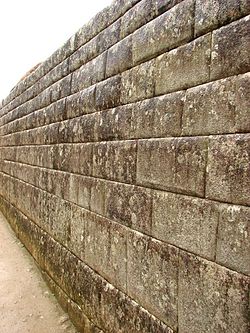- Ashlar
-
Ashlar is prepared stone work (i.e., dressed, cut) of any type of stone. Masonry using such stones laid in parallel courses is known as ashlar masonry, whereas masonry using irregularly shaped stones is known as rubble masonry. Ashlar blocks are rectangular cuboid blocks that are masonry sculpted to have square edges and smooth faces. The blocks, in European masonry, are generally about 35 centimetres (14 in) in height. When shorter than 30 centimetres (12 in), they are usually called “small ashlar”.
Ashlar blocks were used in the construction of many old buildings as an alternative to brick. Generally the external face is smooth or polished; occasionally it can be decorated by small grooves achieved by the application of a metal comb. (This process is usually used only on a softer stone ashlar block. The decoration is known as mason's drag.)[1]
Contents
Etymology
Middle English: from Old French aisselier, from Latin axilla, diminutive of axis, ‘plank.’
Scope
In Classical architecture, ashlar wall surfaces are contrasted with rustication.
The term is frequently used to describe the dressed stone work of prehistoric Greece and Crete, although the dressed blocks are usually much greater than the 30 centimetres (12 in) to 35 centimetres (14 in) mentioned above. For example, the tholos tombs of Bronze Age Mycenae use ashlar masonry in the construction of the so-called “bee-hive” dome. This dome consists of finely cut ashlar blocks that decrease in size and terminate in a central “capstone”.[2] These domes are not true domes, but are constructed using the corbel arch.
Ashlar masonry is also heavily used in the construction of palace facades on Crete, including Knossos and Phaistos. These constructions date to the MM III-LM Ib period, ca. 1700–1450 BC.
Freemasonry
In some Masonic jurisdictions, ashlars are used as a symbolic metaphor for progress. A rough ashlar is a stone as taken directly from the quarry, and allegorically represents the Freemason prior to his initiation; a smooth ashlar (or "perfect ashlar") is a stone that has been smoothed and dressed by the experienced stonemason, and allegorically represents the Freemason who, through education and diligence, has learned the lessons of Freemasonry and who lives an upstanding life.
References
- ^ "The Conservation Glossary". University of Dundee. http://www.trp.dundee.ac.uk/research/glossary/ashlar.html. Retrieved 2009-05-04.
- ^ Preziosi, D.; Hitchcock, L.A. (1999). Aegean Art and Architecture. Oxford History of Art. pp. 175–6. ISBN 0192842080. http://books.google.com/books?id=2tn3ffOnbocC&pg=PA175.
External links
 Media related to Ashlar at Wikimedia Commons
Media related to Ashlar at Wikimedia CommonsStonemasonry Types Materials List of stone • Artificial stone • Brick • Cast stone • Decorative stones • Dimension stone • Fieldstone • Flagstone • Gabions • Granite • Marble • Mortar • Sandstone • SlateTools Angle grinder • Bush hammer • Ceramic tile cutter • Chisel • Diamond blade • Lewis (lifting appliance) • Non-explosive demolition agents • Plug and feather • Stonemason's hammer • StraightedgeTechniques Products Organizations Categories:- Architectural elements
- Construction
- Garden features
- Masonic symbolism
Wikimedia Foundation. 2010.

